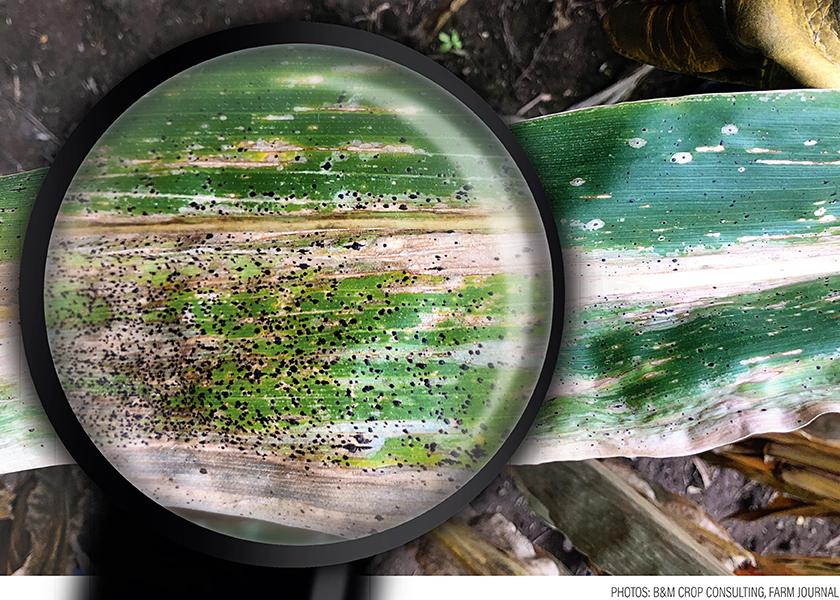Want More ROI from Fungicide Use in Corn? Fine-Tune Your Strategy

If your traditional approach to fungicide applications in corn is to wait until you see signs of disease pressure, it could be time to rethink your strategy.
One reason has to do with the concept of disease latency – the period of time between when a disease infects a plant and when it begins reproducing.
During this timeframe, human eyes are unable to see disease presence or symptoms, according to Kim Tutor, BASF technical marketing manager for plant health.
Nonetheless, she says a disease in the latent stage can invade crop tissue and produce toxins that wreak havoc inside the plant and decrease its productivity and, ultimately, yield.
Every Disease Is Different
A latent period exists for all diseases, regardless of crop type. Some of the latent periods for economically concerning diseases in corn and soybean crops include:
• Frogeye leaf spot – 7 to 10 days
• Target spot – 8 days
• Southern rust – 7 to 10 days
• Tar spot – 14 to 20 days
Different Schools Of Thought
The ongoing question – and debate – among company researchers, university Extension and other agronomic advisors is when to apply a foliar fungicide.
Historically, university Extension crop specialists have said to apply fungicide when you can see the disease is present and you know treatment will provide a return on investment. One of Extension’s concerns is if you treat without knowing the disease is present at a high enough infection load, you stand to lose money on the application. The other concern is if you treat prematurely, you could also be setting up an environment for resistance to build.
BASF commonly recommends farmers use a planned, preventive application of a fungicide with multiple active ingredients and a long residual – at least once per season – to protect corn and soybeans from disease before its presence can be seen on the plants.
“If you're looking to just make one fungicide application, generally speaking, if I take all the data that I have access to, and summarize it, the sweet spot for fungicide applications in corn is going to be right around VT R1,” Tutor says.
Given current corn prices, Tutor contends a proactive fungicide application will safeguard yield potential and pay for itself at harvest with more bushels.
One Heightened Disease Concern
Tar spot is of increasing concern throughout the Corn Belt. “Tar spot can be infecting the plant, causing damage internally for two to three weeks before we are able to detect a lesion or see symptomology on the surface of the leaf,” Tutor says.
A severely infected field can reach yield losses upwards of 60 bushels per acre, according to Dan Quinn, Extension corn specialist, and Darcy Telenko, field crops pathologist, Purdue University.
Tutor adds, “I would never recommend to somebody who’s in tar spot country, ‘Oh, yeah, just go out at (VT) R1 and spray. You'll be fine.’ No, you need to think more proactively and more productively, and consider putting on a fungicide sooner to protect that crop.”
The sense of urgency Tutor and other agronomic advisers have regarding tar spot is understandable: it can infect corn at any growth stage and kill plants with breathtaking speed.
“It can completely overwhelm a corn plant in 10 days to two weeks,” explains Ryan Gentle, agronomy manager, Wyffels Hybrids.
“Spores can enter a field from crop residue or blow in on the wind from a neighbor’s field miles away,” he says. “We have to be proactive in scouting.”
Tar spot decimated a lot of cornfields in 2021, but its impact this season is still unknown and a big question mark.
Gentle says factors that favor tar spot development include:
• Cool, prolonged period of leaf wetness (more than 7 hours). Corn under irrigation is highly susceptible.
• 60-70 degree temperatures
• Relative humidity of 75% or greater
You Might Need Two Applications
Tutor says if you are in a situation where models show significant disease pressure is moving into your area or you are based in an area with tar spot pressure, to consider making an early application with a fungicide that has residual control during what she calls an optimized application window.
“Applications can go out as early as V10 and go all the way up through R3,” she says.
If you are in an area with heavy tar spot levels or you are looking to push the envelope for yield, BASF recommends making two fungicide applications in corn, keeping applications 20 to 28 days apart.
“I'm going to target that first fungicide application around V12 to V14 and that second application around R 3,” she says.
To evaluate BASF fungicides, she says to check out the company’s RevX Fields, a large-scale fungicide trial program. Nearly 2,000 corn and soybeans farmers are participating in the program across the U.S. and sharing the results from their fields. Learn more at https://www.revxfield.com/
“We just encourage anybody that has any questions and wants to see how the products perform locally in their specific area or their region to go and check it out,” Tutor adds.







